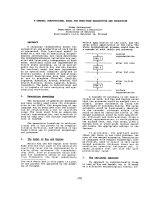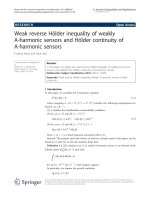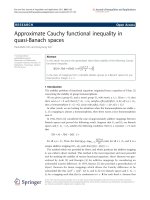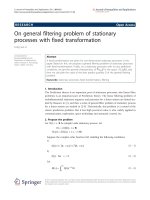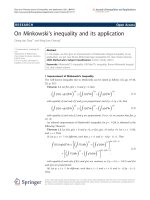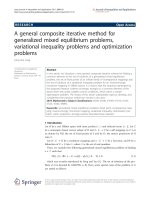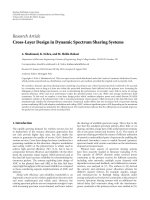Báo cáo hóa học: " PARAMETRIC GENERAL VARIATIONAL-LIKE INEQUALITY PROBLEM IN UNIFORMLY SMOOTH BANACH SPACE" pot
Bạn đang xem bản rút gọn của tài liệu. Xem và tải ngay bản đầy đủ của tài liệu tại đây (555.04 KB, 13 trang )
PARAMETRIC GENERAL VARIATIONAL-LIKE INEQUALITY
PROBLEM IN UNIFORMLY SMOOTH BANACH SPACE
K. R. KAZMI AND F. A. KHAN
Received 18 October 2005; Revised 10 April 2006; Accepted 24 April 2006
Using the concept of P-η-proximal mapping, we study the existence and sensitivity anal-
ysis of solution of a parametric general variational-like inequality problem in uniformly
smooth Banach space. The approach used may be treated as an extension and unification
of approaches for studying sensitivity analysis for various important classes of variational
inequalities given by many authors in this direction.
Copyright © 2006 K. R. Kazmi and F. A. Khan. This is an open access article distributed
under the Creative Commons Attribution License, which permits unrestricted use, dis-
tribution, and reproduction in any medium, provided the original work is properly cited.
1. Introduction
Variational inequality theory has become a very effective and powerful tool for studying a
wide range of problems arising in mechanics, contact problems in elasticity, optimization,
and control, management science, operation research, general equilibrium problems in
economics and tr ansportation, unilateral obstacle, moving boundary-valued problems,
andsoforth,see,forexample,[3, 12, 15]. Variational inequalities have been generalized
and extended in different directions using novel and innovative techniques.
In recent years, much attention has been given to develop general methods for the sen-
sitivity analysis of solution set of various classes of variational inequalities (inclusions).
From the mathematical and engineering point of view, sensitivity properties of various
classes of variational inequalities can provide new insight concerning the problems being
studied and can stimulate ideas for solving problems. The sensitivity analysis of solu-
tion set for variational inequalities has been studied extensively by many authors using
quite different methods. By using the projection technique, Dafermos [4], Mukherjee
and Verma [17], Noor [18], and Y
ˆ
en [23] studied the sensitivity analysis of solution of
some classes of v ariational inequalities with single-valued mappings. By using the im-
plicit function approach that makes use of normal mappings, Robinson [22]studiedthe
sensitivity analysis of solutions for variational inequalities in finite-dimensional spaces.
By using proximal (resolvent) mapping technique, Adly [1], M. A. Noor and K. I. Noor
Hindawi Publishing Corporation
Fixed Point Theory and Applications
Volume 2006, Article ID 42451, Pages 1–13
DOI 10.1155/FPTA/2006/42451
2 Parametric general variational-like inequality problem
[19], and Agarwal et al. [2] studied the sensitivity analysis of solution of some classes of
quasi-variational inclusions with single-valued mappings.
Recently, by using projection and proximal techniques, Ding and Luo [9], Liu et al.
[16], Park and Jeong [21], and Ding [8] have studied the behaviour and sensitivity analy-
sis of solution set for some classes of generalized variational inequalities (inclusions) with
set-valued mappings. It is worth mentioning that most of the results in this direction have
been obtained in the setting of Hilbert space.
Inspired by recent research works going on in this area, in this paper, we consider
a par ametric general var iational-like inequality problem (PGVLIP) in uniformly smooth
Banach space. Further, using P-η-proximal mapping, we study the existence and sensitiv-
ity analysis of the solution of PGVLIP. The method presented in this paper can be used
to generalize and improve the results given by many authors, see, for example, [1–3, 7–
9, 16–19, 21–23].
2. Preliminaries
Let E be a real Banach space equipped with the norm
·.Let·, · denote the dual pair
between E and its dual space E
∗
and let J : E → 2
E
∗
be the normalized duality mapping
defined by
J(u)
=
f ∈ E
∗
, f ,u=u
2
, u=f
E
∗
, ∀u ∈ E. (2.1)
It is well known that if E is smooth,thenJ is single valued and if E
≡ H,aHilbert space,
then J is an identity mapping.
The following concepts and results are needed in the sequel.
Definit ion 2.1 (see [14]). Let P : E
→ E
∗
, g : E → E,andη : E × E → E be single-valued
mappings, then
(i) P is said to be α-strongly η-monotone, if there exists a constant α>0suchthat
P(u) − P(v), η(u,v)
≥
αu − v
2
, ∀u,v ∈ E, (2.2)
(ii) g is said to be k-strongly accretive, if there exists a constant k>0andforanyu,v
∈
E, j(u − v) ∈ J(u − v)suchthat
g(u) − g(v), j(u − v)
≥
ku − v
2
, (2.3)
where j is a selection of set-valued mapping J,
(iii) η is said to be τ-Lipschitz continuous, if there exists a constant τ>0suchthat
η(u,v)
≤
τu − v, ∀u,v ∈ E. (2.4)
Example 2.2. If E
≡ (−∞,+∞), P(u) ≡−u, η(u,v) ≡−(1/2)(u − v), for all u,v ∈ E,then
P is 1/2-strongly η-monotone and η is 1/2-Lipschitz continuous.
Definit ion 2.3 (see [5]). Let η : E
× E → E be a single-valued mapping. A proper func-
tional φ : E
→ R ∪{+∞} is said to be η-subdifferentiable at a point u ∈ E if there exists a
K. R. Kazmi and F. A. Khan 3
point f
∗
∈ E
∗
such that
φ(v)
− φ(u) ≥
f
∗
,η(v, u)
, ∀v ∈ E, (2.5)
where f
∗
is called η-subgradient of φ at u. The set of all η-subgradients of φ at u is denoted
by ∂
η
φ(u). The mapping ∂
η
φ : E → 2
E
∗
defined by
∂
η
φ(u) =
f
∗
∈ E
∗
: φ(v) − φ(u) ≥
f
∗
,η(v, u)
, ∀v ∈ E
(2.6)
is said to be η-subdifferential of φ at u.
Definit ion 2.4 (see [13]). A functional f : E
× E → R ∪{+∞} is said to be 0-diagonally
quasi-concave (0-DQCV) in u,ifforanyfiniteset
{u
1
, ,u
n
}⊂E and for any v =
n
i
=1
λ
i
u
i
with λ
i
≥ 0and
n
i
=1
λ
i
= 1, min
1≤i≤n
f (u
i
,v) ≤ 0holds.
Definit ion 2.5 (see [14]). Let η : E
× E → E be a single-valued mapping. Let φ : E → R ∪
{
+∞} be a lower semicontinuous, η-subdifferentiable (may not be convex) and proper
functional and let P : E
→ E
∗
be a nonlinear mapping. If for any given point u
∗
∈ E
∗
and
ρ>0, there exists a unique point u
∈ E satisfy ing
P(u) − u
∗
,η(v, u)
+ ρφ(v) − ρφ(u) ≥ 0, ∀v ∈ E, (2.7)
then the mapping u
∗
→ u, denoted by P
∂
η
φ
ρ
(u
∗
), is called P-η-proximal mapping of φ.
Clearly, u
∗
− P(u) ∈ ρ∂
η
φ(u) and then it follows that
P
∂
η
φ
ρ
u
∗
=
P + ρ∂
η
φ
−1
u
∗
. (2.8)
Remark 2.6 (see [14]). (i) If η(v, u)
≡ v − u for all u,v ∈ E and φ is a lower semicontin-
uous and proper functional on E, then the P-η-proximal mapping of φ reduces to the
P-proximal mapping of φ discussed by Ding and Xia [11].
(ii) If E
≡ H,aHilbertspace,η(v,u) ≡ v − u for all u,v ∈ H and φ is a convex, lower
semicontinuous and proper functional on E,andP is the identity m apping on H,then
the P-proximal mapping of φ reduces to the usual proximal (resolvent) mapping of φ on
Hilbert space.
Lemma 2.7 (see [14]). Let E be a real reflexive Banach space; let η : E
× E → E be a con-
tinuous mapping such that η(v,v
)+η(v
,v) = 0 for all v,v
∈ E;letP : E → E
∗
be α-
strongly η-monotone continuous mapping; let, for any given u
∗
∈ E
∗
,thefunctionh(v,u) =
u
∗
− P(u),η(v,u) be 0-DQCV in v and let φ : E → R ∪{+∞} be a lower semicontinu-
ous, η-subdifferentiable and proper functional on E.Thenforanygivenconstantρ>0 and
u
∗
∈ E
∗
, there exists a unique u ∈ E such that
P(u) − u
∗
,η(v, u)
≥
ρφ(u) − ρφ(v), ∀v ∈ E, (2.9)
that is, u
= P
ρ
∂
η
φ
(u
∗
).
4 Parametric general variational-like inequality problem
Example 2.8 (see [10]). Let E
=
R
be real line; let P : R → R be defined by P(u) = u,and
let η :
R × R → R be defined by
η(u,v)
=
⎧
⎪
⎪
⎪
⎪
⎨
⎪
⎪
⎪
⎪
⎩
u − v if |uv| < 1,
|uv|(u − v)if1≤|uv| < 2,
2(u
− v)if2≤|uv|.
(2.10)
Then it is easy to see that
(i)
η(u,v), u − v≥|u − v|
2
for all u,v ∈ E, that is, η is 1-strongly monotone,
(ii) η(u,v)
=−η(v,u)forallu,v ∈ R,
(iii)
|η(u,v)|≤2|u − v| for all u,v ∈ R, that is, η is 2-Lipschitz continuous,
(iv) for any given u
∈ E, the function h(v,x) =u − x,η(v,x)=(u − x) η(v,x)is0-
DQCV in v.
If it is false, then there exist a finite set
{v
1
, ,v
n
} and w =
n
i
=1
λ
i
v
i
with λ
i
≥ 0and
n
i
=1
λ
i
= 1suchthatforeachi = 1, ,n,
0 <h
v
i
,w
=
⎧
⎪
⎪
⎪
⎪
⎨
⎪
⎪
⎪
⎪
⎩
(u − w)(v − w)if
v
i
w
< 1,
(u
− w)
v
i
w
(v − w)if1≤
v
i
w
< 2,
2(u
− w)(v − w)if2≤
v
i
w
.
(2.11)
It follows that (u
− w)(v
i
− w) > 0foreachi = 1, ,n, and hence we have
0 <
n
i=1
λ
i
(u − w)
v
i
− w
=
(u − w)(w − w) = 0, (2.12)
which is impossible. This proves that for any given u
∈ R, the function h(v,x)is0-DQCV
in v. Therefore, η satisfies all assumptions in Lemma 2.7.
Remark 2.9 (see [14]). Lemma 2.7 shows that for any strongly monotone continuous
mapping P : E
→ E
∗
and ρ>0, the P-η-proximal mapping P
∂
η
φ
ρ
: E
∗
→ E of a lower semi-
continuous, η-subdifferentiable and proper functional φ is well defined and for each
u
∗
∈ E
∗
, u = P
∂
η
φ
ρ
(u
∗
) is the unique solution of the problem (2.9).
Lemma 2.10 (see [14]). Let E be a real reflexive Banach space and let η : E
× E → E be
τ-Lipschitz continuous such that η(v, v
)+η(v
,v) = 0 for all v,v
∈ E;letP : E → E
∗
be α-
strongly η-monotone continuous mapping; let, for any given u
∗
∈ E
∗
,thefunctionh(v,u) =
u
∗
− P(u),η(v,u) be 0-DQCV in v;letφ : E → R ∪{+∞} be a lower semicontinuous, η-
subdifferentiable and proper functional on E and let ρ>0 be any given constant. Then the
P-η-proximal mapping P
∂
η
φ
ρ
of φ is τ/α-Lipschitz continuous.
Throughout the rest of the paper unless otherwise stated, let E be a real uniformly
smooth Banach space with ρ
E
(t) ≤ ct
2
for some c>0, where ρ
E
is the modulus of smooth-
ness defined below.
K. R. Kazmi and F. A. Khan 5
Lemma 2.11 (see [5]). Let E be a real uniformly smooth Banach space and let J : E
→ E
∗
be
the normalized duality mapping. Then, for all u,v
∈ E,
(i)
u + v
2
≤u
2
+2v,J(u + v),
(ii)
u−v,Ju−Jv≤2d
2
ρ
E
(4u−v/d),whered=
(u
2
+v
2
)/2, ρ
E
(t)=sup{(u+
v)/2 − 1:u=1, v=t} is called the modulus of smoothness of E.
Let T,A : E
→E
∗
, g : E→E, η : E×E → E, N : E
∗
×E
∗
→E
∗
be the given nonlinear map-
pings and let φ : E
× E → R ∪{+∞} be a lower semicontinuous, η-subdifferentiable (may
not be convex) and proper functional such that g(u)
∈ ∂
η
φ(u,z), for all u,z ∈ E,thenwe
consider the following general variational-like inequality problem (GVLIP): find u
∈ E
such that
N
T(u),A(u)
,η
v,g(u)
+ φ(v,u) − φ
g(u),u
≥
0, ∀v ∈ E. (2.13)
Some special cases of GVLIP (2.13).
(i) If N(T(u),A(u))
≡ M(Tu,Au) − w
∗
,forallu ∈ E,whereM : E
∗
× E
∗
→ E
∗
and
w
∗
∈ E
∗
fixed, and g ≡ I, identity mapping, then GVLIP (2.13) reduces to the
following problem. Find u
∈ E such that
M(Tu,Au) − w
∗
,η(u,v)
+ φ(u,v) − φ(u,u) ≥ 0, ∀v ∈ E. (2.14)
This problem has been studied by Ding [6].
(ii) If N(T(u), A(u))
≡ T(u) − A(u), for all u ∈ E,thenGVLIP(2.13) reduces to the
following problem: find u
∈ E such that
T(u) − A(u),η(v,g(u)
+ φ(v,u) − φ
g(u),u
≥
0, ∀v ∈ E. (2.15)
This problem has been studied by Ding and Luo [10] in the setting of Hilbert
space.
(iii) If N(T(u),A(u))
≡ S(u), for all u ∈ E,whereS : E → E
∗
, g ≡ I,andφ(u,v) ≡ 0,
for all u,v
∈ E,thenGVLIP(2.13) reduces to the following problem: find u ∈ E
such that
S(u),η(v, u)
≥
0, ∀v ∈ E. (2.16)
This problem has been studied by Parida et al. [20] in the setting of Euclidean
space.
(iv) If N(T(u),A(u))
≡ S(u), for all u ∈ E, η(u,v) ≡ u − v,forallu,v ∈ E, g ≡ I,then
GVLIP (2.13) reduces to the following problem: find u
∈ E such that
S(u),v − u
+ φ(v,u) − φ(u,u) ≥ 0, ∀v ∈ E. (2.17)
This problem has been studied by M. A. Noor and K. I. Noor [19] in the setting
of Hilbert space.
(v) If, in problem (2.17), φ(u,v)
≡ φ(u), for all u,v ∈ E,thenproblem(2.17)reduces
to the following problem: find u
∈ E such that
T(u),v − u
+ φ(v) − φ(u) ≥ 0, ∀v ∈ E. (2.18)
6 Parametric general variational-like inequality problem
Problems (2.13)–(2.18) have many significant applications in physical, mathe-
matical, pure and applied sciences, see [3, 6, 10, 12, 15, 20].
Next, we consider the parametric problem corresponding to GVLIP (2.13).
Let M be a nonempty open subset of E in which the parameter λ takes the values.
Let T,A : E
× M → E
∗
, g : E × M → E, η : E × E → E, N : E
∗
× E
∗
× M → E
∗
be given
single-valued mappings and let φ : E
× E × M → R ∪{+∞} be a lower semicontinuous,
η-subdifferentiable and proper functional such that g(u,λ)
∈ ∂
η
φ(u,v, λ), for all u,v ∈ E,
λ
∈ M. We consider the following parametric general variational-like inequality problem
(PGVLIP): find u
∈ E such that
N
T(u,λ),A(u,λ),λ
,η
v,g(u,λ)
+ φ(v,u,λ) − φ
g(u,λ),u,λ
≥
0, ∀v ∈ E. (2.19)
3. Existence of solution and sensitivity analysis
First, we prove the following technical result.
Proposition 3.1. u
∈ E is the solution of PGVLIP (2.19) if and only if it satisfies the relation
g(u,λ)
= P
∂
η
φ(·,u,λ)
ρ
[P ◦ g(u,λ) − ρN(T(u,λ),A(u,λ),λ)], (3.1)
where P
∂
η
φ(·,u,λ)
ρ
= (P + ρ∂
η
φ(·,u,λ))
−1
is the P-η-proximal mapping of φ for each fixed
u
∈ E, λ ∈ M, P : E → E
∗
, P ◦ g(·,λ) denotes P composition g(·,λ),andρ>0 is a constant.
Proof. Assume that u
∈ E satisfies (3.1), that is,
g(u,λ)
= P
∂
η
φ(·,u,λ)
ρ
P ◦ g(u,λ) − ρN
T(u,λ),A(u,λ),λ
. (3.2)
Since P
∂
η
φ(·,u,λ)
ρ
= (P + ρ∂
η
φ(·,u,λ))
−1
, the above relation holds if and only if
P
◦ g(u,λ) − ρN
T(u,λ),A(u,λ),λ
∈
P ◦ g(u,λ)+ρ∂
η
φ
g(u,λ),u,λ
. (3.3)
By the definition of η-subdifferential of φ(g(u,λ), u,λ), the above inclusion holds if
and only if
φ(v,u,λ)
− φ
g(u,λ),u,λ
≥
N
T(u,λ),A(u,λ),λ
,η
v,g(u,λ)
, ∀v ∈ E, (3.4)
that is, u
∈ E is the solution of PGVLIP (2.19). This completes the proof.
Now, assume that for some λ ∈ M,PGVLIP(2.19)hasasolutionu and K is a closed
sphere in E centered at
u. We are interested in investigating those conditions under which,
for each λ in a neighborhood of
λ,PGVLIP(2.19) has a unique solution u(λ) near u and
the solution u(λ) is Lipschitz continuous.
Next, we give the following concepts.
Definit ion 3.2. The mapping g : K
× M → E is said to be
(i) locally k-strongly accretive, if there exists a constant k>0suchthat
g(u,λ) − g(v, λ),J(u − v)
≥
ku − v
2
, (3.5)
K. R. Kazmi and F. A. Khan 7
(ii) locally (σ
1
,σ
2
)- Lipschitz continuous, if there exist constants σ
1
,σ
2
> 0suchthat
g(u,λ) − g(v,
λ)
≤
σ
1
u − v + σ
2
λ −
λ, ∀u,v ∈ K, λ,
λ ∈ M. (3.6)
Definit ion 3.3. Let P : E
→ E
∗
, g : K × M → E, T,A : K × M → E
∗
, N : E
∗
× E
∗
× M → E
∗
,
then N is said to be
(i) locally α-strongly P
◦ g-accretive with respect to T and A, if there exists a constant
α>0suchthat
N
T(u,λ),A(u,λ),λ
−
N
T(v,λ),A(v,λ),λ
,
J
∗
P ◦ g(u,λ) − P ◦ g(v,λ)
≥
αu − v
2
, ∀u,v ∈ K, λ ∈ M,
(3.7)
where J
∗
: E
∗
→ E is a normalized duality mapping,
(ii) locally (β
1
,β
2
,β
3
)- Lipschitz continuous, if there exist constants β
1
,β
2
,β
3
> 0such
that
N
u
1
,v
1
,λ
−
N
u
2
,v
2
,
λ
≤
β
1
u
1
− u
2
+ β
2
v
1
− v
2
+ β
3
λ −
λ, ∀u
1
,u
2
,v
1
,v
2
∈ K, λ,
λ ∈ M.
(3.8)
Using the technique of Daformos [4], we consider the mapping F(
·,λ):K × M → E
defined by
F(u,λ):
= u − g(u,λ)+P
∂
η
φ(·,u,λ)
ρ
P ◦ g(u,λ) − ρN
T(u,λ),A(u,λ),λ
. (3.9)
Remark 3.4. It follows from Proposition 3.1 that the fixed point of the mapping F defined
by (3.9)isthesolutionofPGVLIP(2.19).
Now, we show that the mapping F(u,λ)definedby(3.9) is a contraction mapping with
respect to u uniformly in λ
∈ M.
Theorem 3.5. Let the mapping g : K
× M → E be locally k-strongly accretive and locally
(σ
1
,σ
2
)-Lipschitz continuous; let T,A : K × M → E
∗
be locally -Lipschitz continuous and
locally ξ-Lipschitz continuous, respectively; let η : E
× E → E be τ-Lipschitz continuous such
that η(u,v)+η(v, u)
= 0,forallu,v ∈ E and let P : E → E
∗
be δ-strongly η-monotone
continuous mapping; the fuction h(v,u)
=u
∗
− P(u),η(u,v) be 0-DQCV in v.Letφ :
E
× E → R ∪{+∞} be a lower semicontinuous, η-subdifferentiable and proper functional
such that g(u,λ)
∈ ∂
η
φ(u,v, λ),forallu,v ∈ E, λ ∈ M;letP ◦ g : K × M → E
∗
be locally
(γ
1
,γ
2
)-Lipschitz continuous and let N : E
∗
× E
∗
× M → E
∗
be locally α-strong ly P ◦ g-
accretive with respect to T and A and locally (β
1
,β
2
,β
3
)-Lipschitz continuous. If there are
8 Parametric general variational-like inequality problem
some real constants ν
1
> 0 and ρ>0 such that
P
∂
η
φ(·,u,λ)
ρ
(z) − P
∂
η
φ(·,v,λ)
ρ
(z)
≤
ν
1
u − v, ∀u,v ∈ E, z ∈ E
∗
, λ ∈ M, (3.10)
ρ −
α
64c
β
1
+ β
2
ξ
2
<
α
2
− 64c
β
1
+ β
2
ξ
2
γ
2
1
−
δ
2
/τ
2
1 − l
2
64c
β
1
+ β
2
ξ
2
,
α>
β
1
+ β
2
ξ
64c
γ
2
1
−
τ
2
δ
2
(1 − l
2
)
, γ
1
>
τ
δ
1 − l
2
, l<1,
(3.11)
where l
= ν
1
+
1 − 2k +64cσ
2
1
. Then, for each u
1
,u
2
∈ E, λ ∈ M,
F
u
1
,λ
−
F
u
2
,λ
≤
θ
u
1
− u
2
, (3.12)
where θ
=l+( τ/δ)t(ρ) ∈ (0, 1), t(ρ)=
γ
2
1
− 2ρα + ρ
2
64c(β
1
+ β
2
ξ)
2
, that is, F is θ-contraction
uniformly in λ
∈ M.
Proof. For all u
1
,u
2
∈ E, λ ∈ M, using condition (3.10), locally (γ
1
,γ
2
)-Lipschitz conti-
nuity of P
◦ g and locally -Lipschitz continuity of T,wehave
F
u
1
,λ
−
F
u
2
,λ
=
u
1
− g
u
1
,λ
+ P
∂
η
φ(·,u
1
,λ)
ρ
P ◦ g
u
1
,λ
−
ρN
T
u
1
,λ
,A
u
1
,λ
,λ
−
u
2
− g
u
2
,λ
+ P
∂
η
φ(·,u
2
,λ)
ρ
P ◦ g
u
2
,λ
−
ρN
T
u
2
,λ
,A
u
2
,λ
,λ
≤
u
1
− u
2
−
g(u
1
,λ
−
g
u
2
,λ
+
P
∂
η
φ(·,u
1
,λ)
ρ
P ◦ g
u
1
,λ
−
ρN
T
u
1
,λ
,A
u
1
,λ
,λ
−
P
∂
η
φ(·,u
2
,λ)
ρ
P ◦ g
u
1
,λ
−
ρN
T
u
1
,λ
,A
u
1
,λ
,λ
+
P
∂
η
φ(·,u
2
,λ)
ρ
P ◦ g
u
1
,λ
−
ρN
T
u
1
,λ
,A
u
1
,λ
,λ
−
P
∂
η
φ(·,u
2
,λ)
ρ
P ◦ g
u
2
,λ
−
ρN
T
u
2
,λ
,A
u
2
,λ
,λ
≤
u
1
− u
2
−
g
u
1
,λ
−
g
u
2
,λ
+ ν
1
u
1
− u
2
+
τ
δ
P ◦ g
u
1
,λ
−
P ◦ g
u
2
,λ
−
ρ
N
T
u
1
,λ
,A
u
1
,λ
,λ
−
N
T
u
2
,λ
,A
u
2
,λ
,λ
.
(3.13)
K. R. Kazmi and F. A. Khan 9
Using Lemma 2.11,locallyk-strongly accretiveness and locally (σ
1
,σ
2
)-Lipschitz con-
tinuity of g,wehave
u
1
− u
2
−
g
u
1
,λ
−
g
u
2
,λ
2
≤
u
1
− u
2
2
− 2
g
u
1
,λ
−
g
u
2
,λ
,J
u
1
− u
2
−
g
u
1
,λ
−
g
u
2
,λ
≤
u
1
− u
2
2
− 2
g
u
1
,λ
−
g
u
2
,λ
,J
u
1
− u
2
+2
g
u
1
,λ
−
g
u
2
,λ
,J
u
1
− u
2
−
J
u
1
− u
2
−
g
u
1
,λ
−
g
u
2
,λ
≤
(1 − 2k)
u
1
− u
2
+64c
g
u
1
,λ
−
g
u
2
,λ
2
≤
1 − 2k +64cσ
2
1
u
1
− u
2
2
.
(3.14)
Since N is locally α-strongly accretive and locally (β
1
,β
2
,β
3
)-Lipschitz continuous, and
T and A are locally
-Lipschitz continuous and local ly ξ-Lipschitz continuous, respec-
tively, we have
N
T
u
1
,λ
,A
u
1
,λ
,λ
−
N
T
u
2
,λ
,A
u
2
,λ
,λ
≤
β
1
T
u
1
,λ
−
T
u
2
,λ
+ β
2
A
u
1
,λ
−
A
u
2
,λ
≤
β
1
+ β
2
ξ
u
1
− u
2
.
(3.15)
Moreover, since P
◦ g is locally (γ
1
,γ
2
)-Lipschitz continuous, then using Lemma 2.11,we
have
P ◦ g
u
1
,λ
−
P ◦ g
u
2
,λ
−
ρ
N
T(u
1
,λ
,A
u
1
,λ
,λ
−
N
T
u
2
,λ
,A
u
2
,λ
,λ
2
≤
P ◦ g
u
1
,λ
−
P ◦ g
u
2
,λ
2
− 2ρ
N
T
u
1
,λ
,A
u
1
,λ
,λ
−
N
T
u
2
,λ
,A
u
2
,λ
,λ
,
J
∗
P ◦ g
u
1
,λ
−
P ◦ g
u
2
,λ
+2ρ
N
T
u
1
,λ
,A
u
1
,λ
,λ
−
N
T
u
2
,λ
,A
u
2
,λ
,λ
,J
∗
P ◦ g
u
1
,λ
−
P ◦ g
u
2
,λ
−
J
∗
P ◦ g
u
1
,λ
−
P ◦ g
u
2
,λ
−
ρ
N
T(u
1
,λ
,A
u
1
,λ
,λ
−
N
T
u
2
,λ
,A
u
2
,λ
,λ
≤
γ
2
1
−2ρα
u
1
−u
2
2
+64cρ
2
N
T
u
1
,λ
,A
u
1
,λ
,λ
−
N
T
u
2
,λ
,A
u
2
,λ
,λ
2
.
(3.16)
Combining (3.13), (3.14), (3.15), and (3.16), we have
F
u
1
,λ
−
F
u
2
,λ
≤
θ
u
1
− u
2
, (3.17)
where
θ :
= l +
τ
δ
t(ρ), l
=
1 − 2k +64cσ
1
2
+ ν
1
, t(ρ) =
γ
2
1
− 2ρα +64cρ
2
β
1
+ β
2
ξ
2
.
(3.18)
10 Parametric general variational-like inequality problem
Next, we have to show that θ<1. It is clear that t(ρ) assumes its minimum value for
¯
ρ
= α/64c(β
1
+ β
2
ξ)
2
with t(
¯
ρ) =
γ
2
1
− α
2
/64c(β
1
+ β
2
ξ)
2
.
For ρ
=
¯
ρ, l +(τ/δ)t(ρ) < 1
→ l<1, then it follows that θ<1forallρ satisfying (3.11).
Hence, it follows that F defined by (3.9)isaθ-contraction mapping uniformly in λ
∈ M.
Therefore, invoking Banach contraction principle, F admits a unique fixed point, say
u(λ), which in turn is a solution of PGVLIP (2.19). This completes the proof.
Remark 3.6. From Theorem 3.5, it is clear that the mapping F defined by (3.9)hasa
unique fixed point u(λ), that is, u(λ)
= F(u,λ).
It also follows from our assumption that the function
¯
u for λ
=
¯
λ is a solution of
PGVLIP (2.19). Again, using Theorem 3.5,weobservethatforλ
=
¯
λ,
¯
u is a fixed point of
F(u,λ) and it is a fixed point of F(u,
¯
λ). Consequently, we conclude that
u(
¯
λ)
=
¯
u
= F
u(
¯
λ),
¯
λ
. (3.19)
Finally, using Theorem 3.5, we show the Lipschitz continuity of the solution of u(λ)of
PGVLIP (2.19).
Theorem 3.7. Let the mappings T, P, g, η, h, P
◦ g be the same as in Theorem 3.5 and
let conditions (3.10)-(3.11)ofTheorem 3.5 hold. Suppose that λ
→ P
∂
η
φ(·,u,λ)
ρ
is γ
2
-Lipschitz
continuous at λ
=
¯
λ, then the function u(λ) is Lipschitz continuous at λ
=
¯
λ.
Proof. For all λ
∈ M, using Theorem 3.5,wehave
u(λ) − u(
¯
λ)
=
F
u(λ),λ
−
F
u(
¯
λ),
¯
λ
≤
F
u(λ),λ
−
F
u(
¯
λ),λ
+
F
u(
¯
λ),λ
−
F
u(
¯
λ),
¯
λ
≤
θ
u(λ) − u(
¯
λ)
+
F
u(
¯
λ),λ
−
F
u(
¯
λ),
¯
λ
,
(3.20)
where θ is g iven by (3.18). Using (3.9) and using the conditions on the mappings T, P, g,
η, P
◦ g,andP
∂
η
φ
φ
(·,u,λ), we have
F
u(
¯
λ),λ
−
F
u(
¯
λ),
¯
λ
=
u(
¯
λ) − g
u(
¯
λ),λ
+ P
∂
η
φ(·,u(
¯
λ),λ)
ρ
P ◦ g
u(
¯
λ),λ
−
ρN
T(u(
¯
λ)
,A
u(
¯
λ)
,λ
−
u(
¯
λ) − g
u(
¯
λ),
¯
λ
+ P
∂
η
φ(·,u(
¯
λ),
¯
λ)
ρ
P ◦ g
u(
¯
λ),
¯
λ
−
ρN
T
u(
¯
λ)
,A
u(
¯
λ)
,
¯
λ
≤
σ
2
λ −
¯
λ
+ ν
2
λ −
¯
λ
+
τ
δ
P ◦ g
u(
¯
λ),λ
−
P ◦ g
u(
¯
λ),
¯
λ
+ ρ
N
T
u(
¯
λ)
,A
u(
¯
λ)
,λ
−
N
T(u(
¯
λ)
,A
u(
¯
λ)
,
¯
λ
≤
σ
2
+ ν
2
λ −
¯
λ
+
τ
δ
γ
2
λ −
¯
λ
+ ρβ
3
λ −
¯
λ
≤
σ
2
+ ν
2
+
γ
2
+ ρβ
3
τ
δ
λ −
¯
λ
.
(3.21)
K. R. Kazmi and F. A. Khan 11
Combining (3.20)and(3.21), we have
u(λ) − u(
¯
λ)
≤
θ
u(λ) − u(
¯
λ)
+
σ
2
+ ν
2
+
γ
2
+ ρβ
3
τ
δ
λ −
¯
λ
, (3.22)
which implies
u(λ) − u(
¯
λ)
≤
σ
2
+ ν
2
δ +
γ
2
+ ρβ
3
τ
δ(1 − θ)
λ −
¯
λ
. (3.23)
Since θ
∈ (0,1), by (3.11), a := ((σ
2
+ ν
2
)δ +(γ
2
+ ρβ
3
)τ)/δ(1 − θ) > 0. Hence, it fol-
lows from ( 3.23)thatu(λ)isa-Lipschitz continuous at λ
=
¯
λ. This completes the proof.
Lemma 3.8. If the assumptions of Theorem 3.7 hold, then there exists a neighborhood N ⊂
M of
¯
λ such that for λ ∈ N,u(λ) is the unique solution of PGVLIP (2.19)intheinteriorof
K.
Proof. It follows by using similar arguments as given in the proof of Theorem 3.7.
Theorem 3.9. Let
¯
u be the solution of PGVLIP (2.19). Let the mappings η, h be the same as
in Theorem 3.5;letg be locally k-strongly accretive and locally (σ
1
,σ
2
)-Lipschitz continuous
at λ
=
¯
λ;letT, A be locally
-Lipschitz continuous and locally ξ-continuous, respectively;
let P be δ-strongly η-monotone continuous mapping; let P
◦ g be locally (γ
1
,γ
2
)-Lipschitz
continuous at λ
=
¯
λ.LetN be locally α-strongly accretive with respect to T and A,and
locally (β
1
,β
2
,β
3
)-Lipschitz continuous at λ =
¯
λ,andletφ be a lower semicontinuous, η-
subdifferentiable functional such that g(u,λ)
∈ ∂
η
φ(u,v, λ),forallu,v ∈ E, λ ∈ M. If con-
ditions (3.10)-(3.11)ofTheorem 3.5 hold and λ
→ P
∂
η
φ(·,u,λ)
ρ
is γ
2
-Lipschitz continuous at
λ
=
¯
λ, then there exists a neighborhood N
⊂ M of
¯
λ such that for λ ∈ N, u(λ) is the unique
solution of PGVLIP (2.19)intheinteriorofK, u(
¯
λ)
=
¯
u, and u(λ) is Lipschitz continuous at
λ
=
¯
λ.
Proof. It follows from Theorems 3.5–3.7, Lemma 3.8,andRemark 3.6.
Example 3.10. If E ≡ R, g(u,λ) ≡ 2u + λ, P(u) ≡ u, T(u,λ) ≡ u +2λ, A(u,λ) ≡ 3u + λ,
N(u, v,λ)
≡ 2u + v + λ, η(u,v) ≡ u − v,forallu,v ∈ R, λ ∈ M.Then
(i) g(u,λ) is 2-strongly monotone and (2,1)-Lipschitz continuous, that is,k
=2, σ
1
=2,
σ
2
= 1;
(ii) P is 1-strongly η-monotone and η is 1-Lipschitz continuous, that is, δ
= 1, τ = 1;
(iii) P
◦ g is (2,1)-Lipschitz continuous, that is, γ
1
= 2, γ
2
= 1;
(iv) T and A are (1,2)-Lipschitz continuous and (3,1)-Lipschitz continuous, that is,
= 1, ξ = 3;
(v) N is 10-strongly P
◦ g-monotone with respect to T and A, and (2,1,1)-Lipschitz
continuous, that is, α
= 10, β
1
= 2, β
2
= β
3
= 1.
If ν
1
=ν
2
=0.1, then after simple calculation, we have |ρ−1.6/3| < 1/3 ⇒ ρ ∈ (0.2,0.8).
For ρ
= 0.75, θ ≈ 0.66.
Further, it is easily observed that a
= ((σ
2
+ ν
2
)δ +(γ
2
+ ρβ
3
)τ)/δ(1 − θ) > 0.
12 Parametric general variational-like inequality problem
References
[1] S. Adly, Perturbed algorithms and sensitivity analysis for a general class of variational inclusions,
Journal of Mathematical Analysis and Applications 201 (1996), no. 2, 609–630.
[2] R.P.Agarwal,N.J.Huang,andY.J.Cho,Generalized nonlinear mixed implicit quasi-variational
inclusions with set-valued mappings, Journal of Inequalities and Applications 7 (2002), no. 6,
807–828.
[3] C. Baiocchi and A. Capelo, Variational and Quasivariational Inequalities. Applications to Free
Boundar y Problems, A Wiley-Interscience Publication, John Wiley & Sons, New York, 1984.
[4] S. Dafermos, Sensitivity analysis in variational inequalities, Mathematics of Operations Research
13 (1988), no. 3, 421–434.
[5] X. P. Ding, Generalized quasi-variational-like inclusions with nonconvex functionals,Applied
Mathematics and Computation 122 (2001), no. 3, 267–282.
[6]
, Existence and algorithm of solutions for nonlinear mixed variational-like inequalities in
Banach spaces, Journal of Computational and Applied Mathematics 157 (2003), no. 2, 419–434.
[7]
, Sensitivity analysis for generalized nonlinear implicit quasi-variational inclusions,Ap-
plied Mathematics Letters 17 (2004), no. 2, 225–235.
[8]
, Parametric completely generalized mixed implicit quasi-variational inclusions involv-
ing h-maximal monotone mappings, Journal of Computational and Applied Mathematics 182
(2005), no. 2, 252–269.
[9] X.P.DingandC.L.Luo,On parametric generalized quasi-variational inequalities,Journalof
Optimization Theory and Applications 100 (1999), no. 1, 195–205.
[10]
, Perturbed proximal point algorithms for general quasi-variational-like inclusions,Journal
of Computational and Applied Mathematics 113 (2000), no. 1-2, 153–165.
[11] X. P. Ding and F. Q. Xia, A new class of completely generalized quasi-variational inclusions in
Banach spaces, Journal of Computational and Applied Mathematics 147 (2002), no. 2, 369–383.
[12] F. Giannessi and A. Maugeri (eds.), Variational Inequalities and Network Equilibrium Problems,
Plenum Press, New York, 1995.
[13] K. Goebel and S. Reich, Uniform Convexity, Hyperbolic Geometry, and Nonexpansive Mappings,
Monographs and Textbooks in Pure and Applied Mathematics, vol. 83, Marcel Dekker, New
York, 1984.
[14] K. R. Kazmi and M. I. Bhat, Convergence and stability of iterative algori thms of generalized set-
valued variational-like inclusions in Banach spaces, Applied Mathematics and Computation 166
(2005), no. 1, 164–180.
[15] N. Kikuchi and J. T. Oden, Contact Problems in Elasticity: A Study of Variational Inequalities
and Finite Element Methods, SIAM Studies in Applied Mathematics, vol. 8, SIAM, Pennsylvania,
1988.
[16] Z. Liu, L. Debnath, S. M. Kang, and J. S. Ume, Sensitivity analysis for parametric completely
generalized nonlinear implicit quasivariational inclusions, Journal of Mathematical Analysis and
Applications 277 (2003), no. 1, 142–154.
[17] R. N. Mukherjee and H. L. Verma, Sensitivity analysis of generalized variational inequalities,Jour-
nal of Mathematical Analysis and Applications 167 (1992), no. 2, 299–304.
[18] M. A. Noor, Sensitivity analysis framework for gene ral quasi-variational inclusions, Computers &
Mathematics with Applications 44 (2002), no. 8-9, 1175–1181.
[19] M.A.NoorandK.I.Noor,Se nsitivity analysis for quasi-variational inclusions,JournalofMath-
ematical Analysis and Applications 236 (1999), no. 2, 290–299.
[20] J. Parida, M. Sahoo, and A. Kumar, A variat ional-like inequality problem, Bulletin of the Aus-
tralian Mathematical Society 39 (1989), no. 2, 225–231.
[21] J.Y.ParkandJ.U.Jeong,Parametric generalized mixed variational inequalities,AppliedMathe-
matics Letters 17 (2004), no. 1, 43–48.
K. R. Kazmi and F. A. Khan 13
[22] S. M. Robinson, Sensitivity analysis of variational inequalities by normal-map techniques,Vari-
ational Inequalities and Network Equilibrium Problems (Erice, 1994) (F. Giannesi and A.
Maugeri, eds.), Plenum, New York, 1995, pp. 257–269.
[23] N. D. Y
ˆ
en, H
¨
older continuity of solutions to a parametric variational inequality,AppliedMathe-
matics and Optimization 31 (1995), no. 3, 245–255.
K. R. Kazmi: Department of Mathematics, Aligarh Muslim University, Aligarh 202 002, India
E-mail address: kr
F. A. Khan: Department of Mathematics, Aligarh Muslim University, Aligarh 202 002, India
E-mail address: faizan
